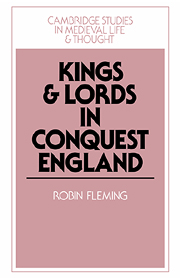Book contents
- Frontmatter
- Contents
- List of figures
- List of tables
- Preface
- List of abbreviations
- PART I CNUT'S CONQUEST
- PART II THE NORMAN CONQUEST
- 4 Domesday Book and the tenurial revolution
- 5 Territories and time
- 6 Private enterprise and the Norman settlement
- 7 Aristocratic landholding and royal power in the eleventh century
- Bibliography
- Index
6 - Private enterprise and the Norman settlement
Published online by Cambridge University Press: 09 October 2009
- Frontmatter
- Contents
- List of figures
- List of tables
- Preface
- List of abbreviations
- PART I CNUT'S CONQUEST
- PART II THE NORMAN CONQUEST
- 4 Domesday Book and the tenurial revolution
- 5 Territories and time
- 6 Private enterprise and the Norman settlement
- 7 Aristocratic landholding and royal power in the eleventh century
- Bibliography
- Index
Summary
Sir Frank Stenton, when describing the destruction of the Anglo-Saxon aristocracy and its replacement by the Conqueror with his kinsmen and his cronies, wrote:
It is remarkable proof of the Conqueror's statesmanship that his tenurial revolution never degenerated into a scramble for land. In every part of England the great redistribution was controlled by the king and carried out by his ministers on lines which [William] himself laid down.
These lines were based on the inheritance of land by a Norman from several well-defined English antecessors: in Stenton's words, ‘the best reply [one of the Conqueror's new lords] could make to a claim upon his property was the production of sworn evidence that the land or the rights in dispute had belonged to his antecessor on the day when King Edward was alive and dead’. Similarly, it was D. C. Douglas's considered opinion that,
it became usual for a Norman lord in England to find himself endowed within each shire not with a miscellaneous collection of manors but rather with all the lands which had formerly belonged to one or more pre-Conquest landowners … while the transference of possession was of course sometimes accompanied by private violence, it was more often effected without disturbance, and it is wholly remarkable how frequently cases of dispute were settled at the king's command by reference to traditional legal process … [and with a] respect for legal precedent.
- Type
- Chapter
- Information
- Kings and Lords in Conquest England , pp. 183 - 214Publisher: Cambridge University PressPrint publication year: 1991
- 1
- Cited by



